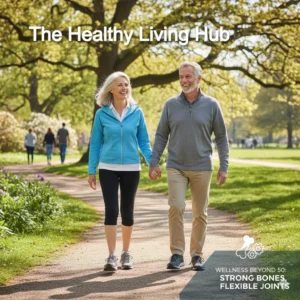Introduction
After the age of 50, the body naturally goes through changes that can significantly impact bone and joint health. Declining bone density, hormonal shifts, and slower tissue repair can lead to issues such as osteoporosis, fractures, and joint stiffness.
The good news is that with the right lifestyle habits, you can maintain strength, flexibility, and independence for decades. This article shares 7 expert-backed tips tailored for US and UK readers, designed to support bone and joint health after 50 using clear, actionable advice.

1. Get Enough Calcium and Vitamin D
Calcium and vitamin D play a crucial role in bone maintenance.
Calcium supports bone structure and strength.
Vitamin D helps your body absorb calcium effectively.
Good sources include dairy products, fortified plant-based milk, leafy greens, nuts, and seeds. Spending 10–15 minutes in sunlight several times a week also helps your body produce vitamin D naturally. If needed, supplements can be considered after consulting a healthcare professional.
2. Include Regular Weight-Bearing and Resistance Exercises
Staying active is one of the best ways to support bone and joint health.
Weight-bearing activities (e.g., walking, light jogging, stair climbing) work against gravity to build bone density.
Resistance exercises (e.g., resistance bands, light weights) strengthen muscles that support joints, improve balance, and reduce fall risk.
A mix of both types of exercise helps improve mobility, balance, and overall skeletal strength.
3. Maintain a Healthy Weight to Reduce Joint Pressure
Extra weight puts added stress on knees, hips, and the spine, leading to joint discomfort and wear over time. Maintaining a balanced weight through simple lifestyle habits can protect your joints and improve mobility.
👉 Along with these tips, you can also explore 3 Simple Ways to Achieve Natural Weight Loss with Yoga, Sunlight & Daily Habits to support overall health naturally.
4. Stay Active Throughout the Day
It’s not just structured workouts that matter — regular movement throughout the day is equally important. Long periods of sitting can cause stiffness, weak muscles, and reduced joint lubrication.
Easy ways to stay active:
Take short walks each hour
Stretch your legs and spine regularly
Use stairs instead of elevators
Engage in light daily chores or hobbies
These small actions help keep joints flexible and bones strong.
5. Protect Your Joints with Good Posture and Techniques
Your posture and movement habits directly affect joint health. Poor posture can cause misalignment, cartilage wear, and discomfort.
Simple tips:
Sit upright with proper back support
Keep your feet flat on the floor
Lift using your legs, not your back
Use ergonomic furniture when possible
Good posture reduces unnecessary pressure and helps maintain healthy alignment.
6. Avoid Smoking and Limit Alcohol
Smoking and excessive alcohol can weaken bones and slow healing.
Smoking reduces blood flow to bone tissue and affects bone density.
Heavy alcohol use interferes with calcium absorption and increases fall risk.
If you smoke, seek help to quit. Keep alcohol intake moderate to support both bone and overall health.
7. Get Regular Health Checkups and Screenings
Regular medical checkups can detect early signs of bone loss or joint problems, allowing timely action.
Ask your doctor about:
Bone density (DEXA) scans
Personalized exercise or physiotherapy plans
Calcium or vitamin D supplement needs
Early treatments if bone loss is detected
🌟 Bonus Tip for Women: Consider HRT
Women tend to experience faster bone loss after menopause due to declining estrogen levels. If you’re concerned about bone density, talk to your doctor about Hormone Therapy (HRT). This treatment can help reduce fracture risk and support bone health during and after menopause.
For a detailed overview, read our guide: Stronger Bones & Better Health: 7 Amazing Benefits of Hormone Therapy After Menopause.
📝 FAQ
Q. What is the difference between Osteoporosis and Arthritis?
Osteoporosis refers to low bone density, which makes bones brittle and more likely to fracture.
Arthritis is inflammation in the joints, causing pain and stiffness. While both affect mobility, they are distinct conditions and often require different management approaches.
References & External Resources (DoFollow)
For more information, refer to these trusted health sources:
Conclusion
Supporting bone and joint health after 50 doesn’t require drastic changes — just smart, consistent habits. Prioritize good nutrition, regular movement, healthy posture, and routine screenings to stay active and strong.
Small, consistent actions today will help you enjoy better mobility, strength, and independence for years to come. 🦴✨
